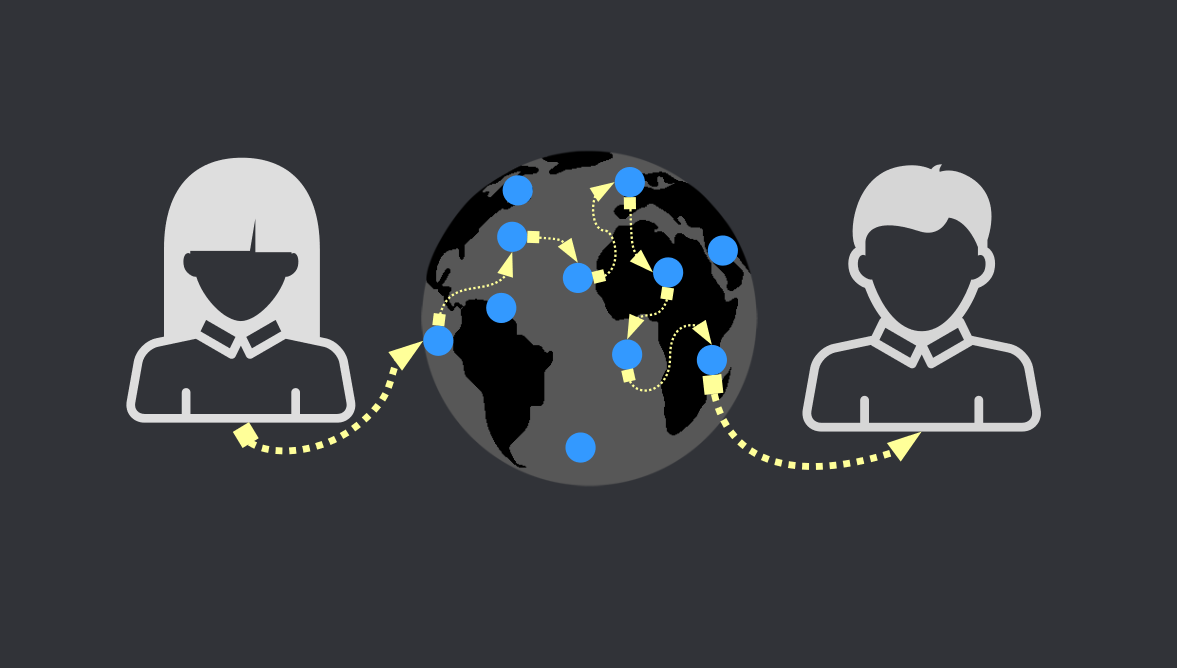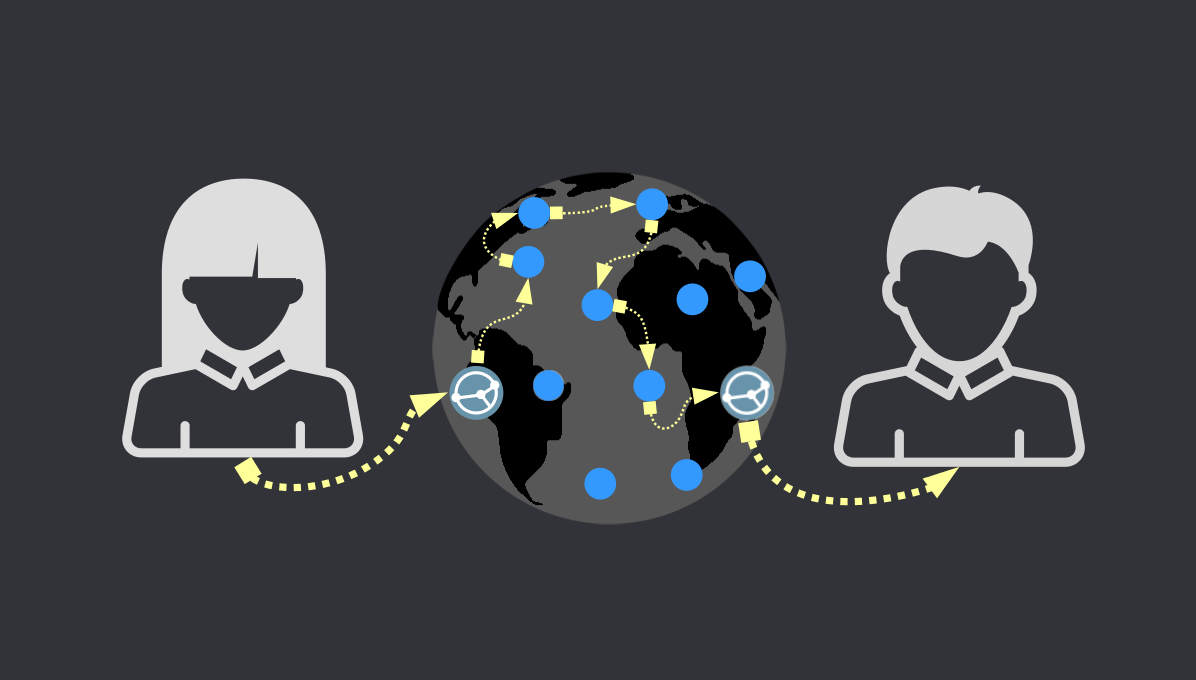roinn faidhlichean gun mhalairt
Images, videos, audio files, text….applications, archives….how can we share files in the digital universe? Popular services such as Dropbox, Google Drive, or iCloud seem to be the “way to go” for the task. However, they ask you for many trades such as currency trade (like money), data, attention (ads and promotions), or artificial limitations in order for you to subscribe for their “pro” or “premium” accounts. You have to trade a lot with them, give them your currency, data, attention, privacy, or register with them in order to use their services.
Here’s Ana and Bubu again. They want to share files with each other. Their photos and videos, or a lot more than that. That’s all they want and the world stays between them. How can they do it?

If they would use one of those popular file sharing platforms, then Ana would have to register with one of them and trade a lot to that company, and after they approve her, Ana can upload the files to that company’s servers via the browser or a desktop/mobile app. She can, at times depending on the service, share the files with Bubu via a custom link that she has to send him via email or any other methods. Sometimes it is required that Bubu should have an account with the same company in order to get the files. This is how most people share the files. Ana goes through a multi-step process to register and trade with a company, to then upload the photos manually to their servers or download and install their desktop application, and then use a 3rd party method such as email to send a link to Bubu. Bubu may need the same desktop application or at times only a browser to receive the files (download or sync them).

On top of the many trades that they are forced to do, their files are controlled 100% by a company. If the company decides that the files are not “ok” (illegal or whatever they may call them), then the company will remove the files. The company can also see Ana’s nude photos if they want to, or Bubu’s love poems that he sends to Ana as text documents. Their file sharing is crippled with trades and completely slave to the company’s rules and “morals”. Other companies such as WeTransfer pretend to be free by letting users upload files up to X GB to their servers and share the uploads with others without users paying any money or registering an account with them. However, as you may understand by now, these are not trade-free since they are often full of ads and data mining techniques.
So, then, how can Ana share large amounts of files (perhaps unlimited) with Bubu in a trade-free way?
In essence there are two main ways one can share files online. First, the classic “upload to a server” style. And this server acts as storage system. It stores the files and the other persons can access them any time. The advantages of such a system is that the files are always available. The biggest downside is that centralizing file sharing comes with a huge responsibility and you never know who is behind these servers or what they do with your files. Also, most such services are limited in terms of storage space.

The second way is the “nodes” way. Multiple servers or people’s computers make the connection with each other, and when Ana shares something the nodes only connect her with Bubu, to then allow for a direct transfer of files between the two. The nodes should not be able to read/access any files that the two are sending.

ÌRE 1: AIRSON WETRANSFER
One simple solution is a sort of WeTransfer that is trade-free. bailiùn tha aon roghainn eile mar sin. Pìos bathar-bog stòr fosgailte as urrainn do dhuine sam bith a chuir a-steach air an t-seirbheisiche aca fhèin agus WeTransfer gun mhalairt a chruthachadh. Seo Tha cuid de shuidheachaidhean Lufi dìreach a 'leigeil leat faidhlichean a luchdachadh suas agus an uairsin lethbhreac a dhèanamh den URL agus a roinn le duine sam bith a tha thu ag iarraidh. Gun bullshit. Gun shanasan. Gun mhèinneadh dàta. Agus air a chrioptachadh, gus nach leugh eisimpleir sam bith na tha thu a’ luchdachadh suas. Tha fuasgladh nas iom-fhillte ach làn-nochdadh Leis na WebApps faodaidh tu làrach-lìn sam bith a thionndadh gu app. Rach gu làrach-lìn sam bith, dèan lethbhreac agus pasg air an URL, thoir ainm dha, agus voila. Tha an webapp a-nis mar phàirt den t-siostam agad mar aplacaid sam bith eile. Ma tha diofar bhrobhsairean agad air an stàladh faodaidh tu gin dhiubh a thaghadh airson na h-obrach. Tagh ìomhaigh àbhaisteach bhon phasgan ìomhaigh no ìomhaigh sam bith bhon choimpiutair agad. Tha sinn a’ moladh na h-aplacaidean lìn trom.tf againn airson seo. Tha iad saor bho mhalairt agus air leth feumail.. Leigidh am fear seo le smachd mòr air faidhlichean (bho thionndadh gu cùl-taic no sioncranachadh fèin-ghluasadach). Ach, mura h-eil fios dha-rìribh aig Ana mar a stàlaicheas agus a ruitheas NextCloud air a’ choimpiutair aice fhèin agus an coimpiutair aice atharrachadh gu lìonra, tha Ana an uairsin aig tròcair luchd-frithealaidh eile (mar ann an cùis Lufi) a dh’ fhaodadh malairt a thoirt seachad (agus cuibhrichte) NextCloud eisimpleirean. Faodaidh seo a bhith gu math tearc a lorg leis gu bheil NextCloud nas motha na seirbheis roinneadh fhaidhlichean agus aoigheachd sìmplidh, agus mar sin feumaidh e tòrr cumhachd frithealaiche. Bidh eadhon na suidheachaidhean a bheir seachad eisimpleir NextCloud “an-asgaidh”, gu tric a ’togail cosgais airson barrachd fheartan stòraidh no“ premium ”, agus mar sin chan eil iad dha-rìribh saor bho mhalairt. Gu dearbh, tha, tha seirbheisean onarach WeTransfer ann a leigeas leat faidhlichean a cho-roinn gun mhalairt. Ach tha iad cuingealaichte a thaobh àite stòraidh.

ÌRE 2: DROPBOX DECENTRALIZED
The best way to share an unlimited amount of files is to directly transfer files from one to another. Nodes do just that, by finding a bridge between Ana and Bubu. So when Ana sends a file to Bubu, the nodes connect the two. The biggest downside is that both Ana and Bubu have to be online for the files to transfer. But since we are pretty much always connected to the internet these days, maybe this is not a huge disadvantage. Considering that no one can delete any of the files you are sharing, this method is by far the most convenient. Think of this method as an offline package delivery service (like the postal service). Ana sends a package to Bubu, and the postal office or the package delivery service is simply getting the package from Ana to Bubu without opening it. That’s how it should be done. Not like Google Driver or Dropbox are doing it, by opening the package and removing any content that they deem as “wrong”. The best part of this Level 2 file-sharing is that the package delivering service doesn’t even know the size of the packages many times, or who Ana or Bubu are.

So, when it comes to file sharing the reliance on servers (centralized means) is going to be limited in terms of how many files you can share or what kinds of, even when we are talking about trade-free services. The best approach is to directly connect Ana and Bubu, not through one point, but multiple (as nodes). This way Ana can send as many nude photos and astronomy photos and videos to Bubu as she wants, and no one would be able to either sniff them or limit how many she can send.
Trade Free alternatives
Bellow we will recommend some trade-free apps for TROMjaro that allow Ana and Bubu to share files with each other. We will emphasize 4 core features for each of them:
EASE OF USE
PRIVATE
RELIABLE
DYNAMIC
Syncthing is perhaps the best file-sharing application. Very easy to use, since all you have to do is to share your ID with your friend, then you are connected. The next simple step is to add a folder to your sharing list, and then share this folder with your friend. Say you create a new folder on your computer and name it “Bubu”. Add it to Syncthing and share it with your friend. Whatever you add to the “Bubu” folder will automatically be shared with your friend and copied to his/her computer. As simple as that. On top of it Syncthing can keep versions of the files, so in case you delete or change any, it will keep a backup of that.
Syncthing comes pre-installed on TROMjaro because it is very easy to use, it is private (the connections to the nodes are encrypted), it is highly reliable and very dynamic since it automatically syncs all changes to any files. It can even be used for backups. The only downside of Syncthing is that it does not support “public shares” – like sharing a “link” or something with multiple people as public. People need to connect to you one by one, in order for you to share files with them. Thus, Syncthing is geared towards private file sharing.
Amule is an application that lets you access the ED2K lìonra. Tha e ag amas air roinneadh fhaidhlichean, seanalan agus cabadaich, agus barrachd. Mar sin chan eil an “furasta a chleachdadh” cho math ma tha thu ag iarraidh cuid de na faidhlichean a cho-roinn le do charaidean. Faodaidh tu ge-tà faidhlichean a cho-roinn gu poblach le neach sam bith air lìonra ED2K no le neach sam bith aig a bheil neach-dèiligidh airson an lìonra. Faodaidh e a bhith cho furasta ri “ceangal” a cho-roinn le do charaid agus e / i ga fosgladh le Amule. Chan eil an earbsachd cho math sin agus chan eil fios againn a bheil an ceangal eadar na nodan (frithealaichean) air a chrioptachadh. Ach faodaidh tu na h-uimhir de fhaidhlichean is phasganan a tha thu ag iarraidh a cho-roinn le Amule agus a bharrachd air an sin cumaidh e sùil air na h-atharrachaidhean a chaidh a dhèanamh air na pasganan sin agus ùraich iad gu fèin-ghluasadach (mar sin, tha e fiùghantach).
Transmission is a BitTorrent neach-dèiligidh. Aon de na lìonraidhean as earbsaiche a-muigh an sin. Gus faidhlichean a cho-roinn le Transmission feumaidh tu faidhle “torrent” a chruthachadh bho fhaidhle no pasgan. Mar sin abair gu bheil thu airson pasgan a cho-roinn le Ana, cuiridh tu am pasgan ri Transmission agus an uairsin feumaidh tu “trackers” (nodan) a chuir ris an liosta le làimh. Mura h-eil thu eòlach air seo bidh e gu math duilich dhut oir is e seo am prìomh rud a dh’ fheumas tu a dhèanamh gus am pasgan agad a bhith “air a lorg” le Ana. Ma thèid agad air seo a dhèanamh, tha e gu math furasta am pasgan a roinn an dàrna cuid tro cheangal (magnet) no tro fhaidhle (torrent), bidh an dithis ag obair mar thunail eadar an dithis agad. Is urrainn dha Ana an ceangal a bheir thu dhi a chopaigeadh gu furasta, gu Transmission agus tòisichidh an luchdachadh sìos.
Transmission, like all BitTorrent clients, is not dynamic. If you share a folder then that’s all you share. Any changes to the folder won’t be pushed to Ana. You will have to repeat the process with every change. Transmission is geared towards one-time-share. If you want to publicly share a non-dynamic folder with the world, BitTorrent is the best way to do it, and Transmission is a very easy to use client if you understand what trackers are and how to add them.
WebTorrent is another BitTorrent client, but this one is perhaps the easiest to use of them all. Again, it does not support dynamic folders and we do not know if the connections to the nodes are encrypted, but to share a folder/file is as easy as clicking “Share Folder” or “Share File”. WebTorrent adds the BitTorrent trackers on its own so all you have to do is to share the magnet link or the torrent file with your friend(s).
The Lìonra DAT 'S e lìonra ùr agus glè inntinneach a th' ann. Tha e a’ toirt cothrom do dhaoine ceangal a dhèanamh ri daoine eile ann an dòigh di-mheadhanaichte. Leis gu bheil e fhathast ùr, chan eil e gu math earbsach agus chan eil ceanglaichean an-còmhnaidh air an stèidheachadh. Ach nuair a bhios e ag obair, tha an deasg DAT ga dhèanamh air leth furasta faidhlichean a cho-roinn agus fhaighinn, oir is e sin an aon adhbhar a tha aig an aplacaid seo. Bidh e a’ cuairteachadh nan ceanglaichean eadar co-aoisean agus a’ toirt taic do phasganan fiùghantach.
So, choose a folder to share with Ana and then send her the unique DAT url so that she can receive it with the DAT Desktop. And any changes you make to that folder, will be automatically pushed to Ana’s computer. As easy as that!
BiglyBT is another BitTorrent client, but it is more complicated to use. However it offers more options. No dynamic folders, but secure and reliable. If Ana wants to use BiglyBT to share files in a more complex manner (with specific rules and such), then BiglyBT can be a good tool for that. Else, Ana is better off sharing files using other apps.
RetroShare is a lot more than a file sharing application. In fact it is not meant for that, it is meant for email, chats, forums, and also file sharing. So, for the average user this may be a bit difficult to navigate if the only thing they need is to share files. It supports dynamic folders though, which is a big plus when you want to share files that you may change, or add/remove files after you have shared a folder.
RetroShare is not that reliable in establishing connections between peers so be aware of that. The fantastic part of RetroShare is that it does not rely on any well-known network. It is its own thing and it is properly-decentralized.
Beaker uses the DAT Network and similar to the DAT Desktop app, it provides all of the features such as dynamic folders and encryption. It is not as easy to use as DAT Desktop because Beaker is more than a file sharing app, so it may take a bit of time to understand how to use it. However one cool thing about Beaker is that you can preview the files in Beaker directly, without downloading them. So say you share 30 videos with Bubu. Send to Bubu the Beaker (DAT) URL and Bubu can simply open that in Beaker and play any video he wants without downloading them. Beaker allows for the perfect combination of sharing something privately or publicly, and to easily access both.
Imagine you have 5.000 photos that you want to share with the world. You simply point Beaker to the folder where you have the photos stored, and then share the DAT URL with the world. Anyone with the link can view your photos with Beaker without downloading them to their computers. And, if you add or remove photos, then you don’t have to do anything, the same URL will work to display the new changes. Of course, is worth mentioning again that the DAT Network is not 100% reliable so at times the connection between users cannot be established.
OnionShare uses the well-known lìonra TOR airson roinneadh fhaidhlichean, rud a tha gu math fionnar. Mar sin tha roinneadh fhaidhlichean gu math prìobhaideach agus gu math earbsach. Gus a chleachdadh, tha e cho sìmplidh ri bhith a’ roinneadh no a’ luchdachadh sìos faidhle / pasgan. Bidh thu a’ taghadh pasgan, an uairsin feitheamh gus am bi e “air a sganadh” a bheir ùine mhòr ma tha mòran fhaidhlichean sa phasgan sin, agus aon uair ‘s gu bheil e deiseil faodaidh tu an ceangal gineadh a cho-roinn ri neach sam bith a chleachdas am Brabhsair TOR. Coltach ris an aplacaid Beaker, faodar ro-shealladh fhaighinn air faidhlichean sa bhrobhsair gun a bhith air an luchdachadh sìos.
But, it does not support dynamic folders and Bubu needs to also install the Brabhsair TOR gus na faidhlichean aig Anna fhaighinn. Cuideachd, is dòcha gum bi na h-astaran luchdachadh sìos gu math slaodach thairis air Lìonra TOR. Ach hey, is e dòigh eile gun mhalairt a th’ ann airson meudan gun chrìoch de fhaidhlichean a cho-roinn le duine sam bith!
This article will be updated from time to time to add new apps to the list.
Aplacaidean co-chosmhail:
gun aplacaidean co-cheangailte.

